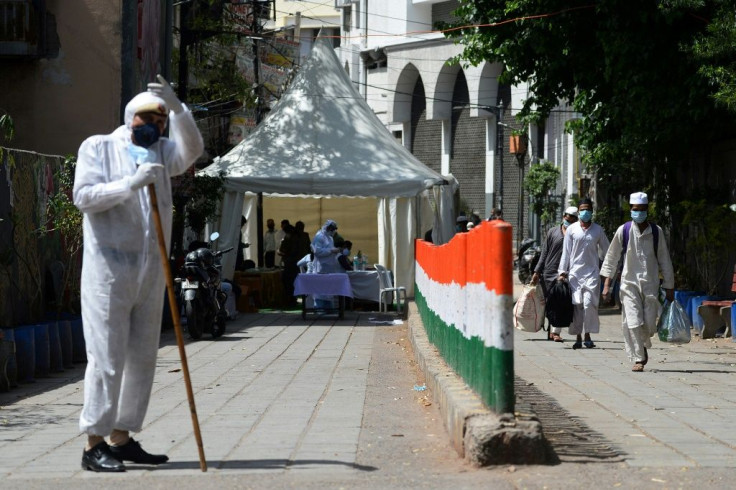Coronavirus May Sharply Cut South Asian Economic Growth, Undo Gains Made Against Poverty: World Bank

KEY POINTS
- World Bank cut its growth forecast for South Asia this year to between 1.8% and 2.8% -- from an earlier estimate of 6.3%
- India is expected to grow by only 1.5% to 2.8% this fiscal year
- India’s government has introduced a $23 billion economic stimulus package
The World Bank warned that the vast economies of South Asia will slow down to rates not seen in four decades due to the ongoing fallout of the coronavirus pandemic and reverse the region’s progress against poverty.
While India, Bangladesh, Sri Lanka, and Pakistan – home to some 1.8 billion people – have reported relatively few coronavirus cases, compared to Europe and the U.S., their dense populations raise fears of the potential of a rapid spread of the illness. (South Asia has thus far confirmed 14,500 cases, with India having for more than 8,000).
The World Bank reduced its growth forecast for the whole region this year to between 1.8% and 2.8% -- down sharply from its original estimate of 6.3% made prior to the virus outbreak.
"The green shoots of a rebound that were observable at the end of 2019 have been overtaken by the negative impacts of the global crisis," the World Bank said.
India, the dominant economy in South Asia, is expected to grow by only 1.5% to 2.8% this fiscal year, down from an expected 4.8% to 5% gain in the prior fiscal year.
“The Covid-19 outbreak came at a time when India’s economy was already slowing, due to persistent financial sector weaknesses,” World Bank stated.
While India, Sri Lanka, Nepal, Bhutan and Bangladesh are expected to endure sharp drops in economic growth, Pakistan, Afghanistan and the Maldives are projected to slip into deep recessions.
Specifically, the Maldives which has witnessed the collapse of tourism, will see its gross domestic output plunge by as much as 13%, while Afghanistan’s economy may contract by as much as 5.9% and Pakistan could drop by 2.2%.
"South Asia finds itself in a perfect storm of adverse effects. Tourism has dried up, supply chains have been disrupted, demand for garments has collapsed and consumer and investor sentiments have deteriorated, international capital is being withdrawn and inflows of remittances are being disrupted," said the World Bank.
To help prevent severe economic dislocation, the World Bank recommended that regional governments "ramp up action to curb the health emergency, protect their people, especially the poorest and most vulnerable, and set the stage now for fast economic recovery.”
The World Bank also suggested temporary work programs for migrant workers, debt relief for businesses and individuals while eliminating bureaucratic obstacles on essential imports and exports.
Meanwhile, the World Bank fears that lack of proper testing has vastly undercounted the true number of virus cases, while lockdowns in overcrowded cities – where social distancing is impossible – will lead to an avalanche of infections and deaths.
“The harsh reality of inequality in South Asia is that poor people are more likely to become infected with the coronavirus, as social distancing is difficult to implement for them,” the World Bank stated. “They also have less access to health care or even soap, are more likely to have lost their job, and are more vulnerable to spikes in food prices.”
Even after lockdowns in India and elsewhere are ended, it could take many months to re-start local economies.
“Factories will not operate at full capacity anytime soon. Production is not going to revive; demand is not going to revive immediately. It is not as if people will suddenly return to shopping malls,” said New Delhi-based economist Arun Kumar. “Therefore, there will be huge joblessness and poverty.”
India’s government has introduced a $23 billion economic stimulus package that will provide direct cash transfers to millions of poor people hurt by the lockdown. Pakistan has unveiled a similar $6 billion program to help support its economy.
The United Nations International Labor Organization earlier reported that the crisis will push India’s huge army of informal workers deeper into poverty,
"COVID-19 is already affecting tens of millions of informal workers. In India, Nigeria and Brazil, the number of workers in the informal economy affected by the lockdown and other containment measures is substantial," the ILO stated. "In India, with a share of almost 90% of people working in the informal economy, about 400 million workers in the informal economy are at risk of falling deeper into poverty during the crisis."
Santosh Mehrotra, an economist at New Delhi’s Jawaharlal Nehru University, warned: “This is a crisis far deeper than the 2008 financial crisis. COVID is going to take India’s growth rate down to probably zero or into negative territory.”
In Bangladesh, the key garment industry has been shuttered amid vanishing demand from western retailers. The sector, which employs some 4 million people, mostly rural women, is stuck with billions of dollars in unsold inventory.
"The priority for all South Asian governments is to contain the virus spread and protect their people, especially the poorest who face considerable worse health and economic outcomes," said Hartwig Schafer, World Bank’s Vice President for the South Asia Region. "Failure to do so can lead to long-term growth disruptions and reverse hard-won progress in reducing poverty.”
Sill, World Bank expects to see an economic rebound in 2022.
"Growth [in India] is expected to rebound to 5% in fiscal 2022 as the impact of COVID-19 dissipates, and fiscal and monetary policy support pays off with a lag,” World Bank added.
© Copyright IBTimes 2024. All rights reserved.




















